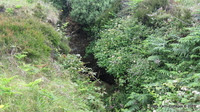 Developed by Sir Isaac Pitman (1813-1897), Pitman Shorthand is a form of phonetic speedwriting. The symbols do not represent letters but sounds. The words are written as they are spoken using a series of strokes, loops and hooks that differ only in thickness and length and where they are placed above, through or below the line. Vowels are light or heavy dots, dashes or dipthongs. It looks mind-boggling on the page but I love it.
Developed by Sir Isaac Pitman (1813-1897), Pitman Shorthand is a form of phonetic speedwriting. The symbols do not represent letters but sounds. The words are written as they are spoken using a series of strokes, loops and hooks that differ only in thickness and length and where they are placed above, through or below the line. Vowels are light or heavy dots, dashes or dipthongs. It looks mind-boggling on the page but I love it. I'm particularly fond of Pitman Shorthand because without it, I wouldn't be a "Resident Alien" and wouldn't be working in the USA.
It was Pitman Shorthand that gave me a "special" skill when I applied for my Green Card many years ago. Who could have possibly imagined that these little squiggles would open a door to a new chapter in my life!
I first learned Pitman Shorthand when I was 19 on a sandwich course (as they were known back in the day) in Cardiff, Wales. We took dictation every day for three straight hours. It was excruciating and I resented it at first. But gradually, my speeds picked up and by the end of the first month I was writing 120 words per minute—that's pretty fast. The average writer writes longhand at 20-30 wpm. A good typist is 50-80 wpm at a push since we're all so keyboard savvy these days. Apparently the fastest shorthand speed attained in a test was 350 wpm by Nathan Behrin in 1922!
Three decades plus later, I can still read my shorthand (I wrote an entire diary one year - obviously not wanting to let my mother read it) - and I still remember how to write the basics though I'm not that fast anymore.
Here is an excerpt from the little book that I purchased for £1.50. I still find shorthand beautiful to look at.
If you're really interested in learning more, check out this fabulous blog called Long Live Pitman's Shorthand and sharpen your pencil.







